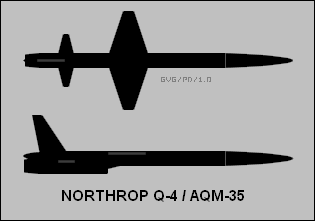
Northrop AQM-35
Encyclopedia
 The AQM-35 was a supersonic
The AQM-35 was a supersonicSupersonic
Supersonic speed is a rate of travel of an object that exceeds the speed of sound . For objects traveling in dry air of a temperature of 20 °C this speed is approximately 343 m/s, 1,125 ft/s, 768 mph or 1,235 km/h. Speeds greater than five times the speed of sound are often...
target drone
Unmanned aerial vehicle
An unmanned aerial vehicle , also known as a unmanned aircraft system , remotely piloted aircraft or unmanned aircraft, is a machine which functions either by the remote control of a navigator or pilot or autonomously, that is, as a self-directing entity...
produced by Northrop
Northrop Corporation
Northrop Corporation was a leading United States aircraft manufacturer from its formation in 1939 until its merger with Grumman to form Northrop Grumman in 1994. The company is known for its development of the flying wing design, although only a few of these have entered service.-History:Jack...
.
Overview
The AQM-35 program began life in 1953 as the Model RP-61 supersonic target drone. In June 1954 the United States Air ForceUnited States Air Force
The United States Air Force is the aerial warfare service branch of the United States Armed Forces and one of the American uniformed services. Initially part of the United States Army, the USAF was formed as a separate branch of the military on September 18, 1947 under the National Security Act of...
awarded Northrop a contract for development of the project as the Q-4; the first flight-capable XQ-4 was launched in 1956.
The XQ-4 was capable of either ground or air launch, though the former mode was never tested. It was powered by an XJ81-WE-3
Rolls-Royce Soar
|-See also:-Bibliography:*Gunston, Bill. World Encyclopedia of Aero Engines. Cambridge, England. Patrick Stephens Limited, 1989. ISBN 1-85260-163-9-External links:* *...
turbojet, allowing it to reach speeds of Mach
Mach number
Mach number is the speed of an object moving through air, or any other fluid substance, divided by the speed of sound as it is in that substance for its particular physical conditions, including those of temperature and pressure...
1.55. The drone's course was followed with radar
Radar
Radar is an object-detection system which uses radio waves to determine the range, altitude, direction, or speed of objects. It can be used to detect aircraft, ships, spacecraft, guided missiles, motor vehicles, weather formations, and terrain. The radar dish or antenna transmits pulses of radio...
, and flight commands were sent by a radio
Radio
Radio is the transmission of signals through free space by modulation of electromagnetic waves with frequencies below those of visible light. Electromagnetic radiation travels by means of oscillating electromagnetic fields that pass through the air and the vacuum of space...
telemetry
Telemetry
Telemetry is a technology that allows measurements to be made at a distance, usually via radio wave transmission and reception of the information. The word is derived from Greek roots: tele = remote, and metron = measure...
system. When the mission was completed the XQ-4 would deploy a three-stage parachute
Parachute
A parachute is a device used to slow the motion of an object through an atmosphere by creating drag, or in the case of ram-air parachutes, aerodynamic lift. Parachutes are usually made out of light, strong cloth, originally silk, now most commonly nylon...
system along with four large inflatable airbags to cushion the impact with the ground.
The Air Force planned to use the Q-4 as a target for various surface-to-air
Surface-to-air missile
A surface-to-air missile or ground-to-air missile is a missile designed to be launched from the ground to destroy aircraft or other missiles...
and air-to-air
Air-to-air missile
An air-to-air missile is a missile fired from an aircraft for the purpose of destroying another aircraft. AAMs are typically powered by one or more rocket motors, usually solid fuelled but sometimes liquid fuelled...
missiles. A secondary reconnaissance
Reconnaissance
Reconnaissance is the military term for exploring beyond the area occupied by friendly forces to gain information about enemy forces or features of the environment....
function was planned, with TV or cameras carried. The drone was air-launched by a Lockheed DC-130 Hercules drone controller aircraft, or other carrier aircraft.
In 1963, the Q-4 family of drones were given the designation AQM-35A and AQM-35B. They were never considered entirely successful, with a variety of problems arising during both the development and flight testing phases. It was also considered that the flight performance of the drone was so high that it was not a realistic test for the missiles being developed - ironic since the whole point of the project was to develop a supersonic target. Only 25 of all types were ever built. The last examples of the type were retired during the 1960s.
Variants
The XQ-4A, was developed to use a have a Fairchild J83 engine and a modified radar signature for testing the CIM-10 Bomarc missile. When the engine could not be developed in time the variant was cancelled.In 1959 Northrop was given a contract to develop an improved XQ-4B fitted with a much more powerful J85-GE-5
General Electric J85
-External links:**...
engine and a strengthened airframe. This variant was first flown in 1961.

